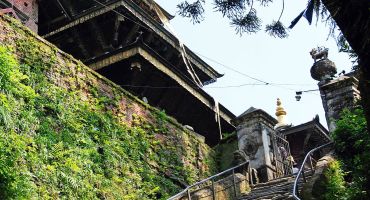Yalambar, by universal acclaim, was the first Kirati King, who, sometime around 1750 BC, came from the east, defeated the Mahishapala King Nimisa, conquered the Nepal valley (Kathmandu), and established a Kirata Kingdom. The evidence for this can be found in two documents. There is the Gopalavamshali which tells us the date of Yalambar’s conquest and there is Padmagiri Vamshali which talks about the Kirata dynasty in Kathmandu. It should be noted that both these documents mention Yalambar as “Yalam” or “Yellung”. No one knows when and how, the name “Yalambar” permeated into popular culture when it should have always been Yellung or Yalam. But what is of more significance is that he really was a real historical figure and not fictional by any measure (as propagated by Mahabharata aficionados).
King Yalambar is also famous in Newari culture and folklore as even today the Newars call the city of Kathamandu, “Ya” and Patan as Yala – both names attributed to the great ruler. There is no doubt that Yalambar has continuously captured the imagination of the indigenous hill people for more than 3 millennia. If a king who holds such sway and popularity today must have been treated with great reverence during his reign and even after his death. He must surely have had a proper burial chamber when he passed on. While historians have seemingly located the ancient Kirata cities during and after the time of Yalambar, the very idea of trying to locate where he could have been buried is rather perplexing and daunting. Yet, it’s not an impossible task.

There are many places in the Kathmandu Valley that are identified with non-Sanskrit names. Lichhavi inscriptions remarkably show time and again, primitive proto-shrines which, today, are worshipped as Balkumari pith, Bhairab pith or the “Jyapu” Newari Digu-Dyo. These are normally feared as they are considered to be inhabited by spirits or ghosts. Such characteristics come from being deemed as burial sites. Such sites are located outside human settlements but also within the accessible perimeter of these human settlements. Many Newari traditions point out to the fact that these sites were indeed burial places in ancient Nepal. Among the many tribes of Nepal that claim Kirata descent, such proto-shrines have divine representations.
Why would the Newari Jyapu community have the tradition of upholding a sacred Digu-Dyo site when the Jyapus are ritualistically cremated rather than being buried? This only makes sense if we understand that the Newari Jyapus actually adhered to a tradition of burying their dead, long before the entire society converted to traditional Hinduism. It can be assumed that the Jyapus can claim to be of Kirata descent even though many historians like Baburam Acharya believe otherwise. But without proper historical documents to ascertain facts, arguments from both sides seem absolutely plausible.
Such sites also flourished as religious places during the Lichhavi era. This was the one thing that baffled Historians for a long time. How can a burial site be considered a shrine? As both divine associations and ancestor worship exists in these places, does it dictate that Royal Individuals may have been buried at these sites? Could it be that a few among the 29 or 32 Kirata kings could be buried at these locations? Maybe even the great Yalambar, himself ?
While we know that Patuka, the 28th King is supposedly buried at Patuka Da (Patan), archaeologists are finally beginning to discover the burial sites of the remaining 28 kings. In Handigaun, an inscription claims that there was a Kirata burial site within its perimeter as early as 1673 CE. Some of the other ancient burial places in Kathmandu are the Chundevi at Bhatbhateni, Charnarayan at Maligaun and Mahalaxmi at Naxal.





Bravo, what a finding, pradeep you have really opened a new chapter for Khambus. Congrat